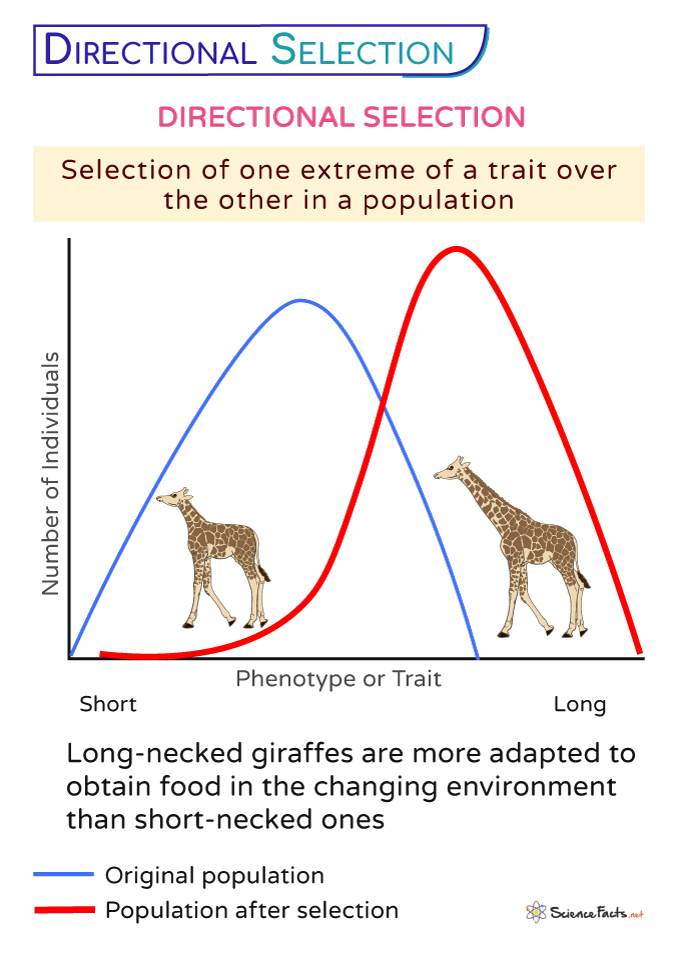Directional Selection
Directional selection is a form of natural selection in which an extreme trait or phenotype is favored over the other, causing the allele frequency to shift towards that phenotype. It is a negative natural selection that occurs due to sudden environmental changes or the migration of a species to a new geographic location with different ecological conditions. Directional selection is one of the common forms of natural selection.
Charles Darwin first proposed this type of natural selection in ‘On the Origin of Species’ after observing the beak length of the Galapagos finches.
Directional Selection Graph
In a statistical analysis, directional selection shows a population bell curve that shifts towards the extreme left or right. However, unlike stabilizing selection, the graph’s height does not change. Also, there are fewer average individuals in the population.
Examples of Directional Selection
Change in Beak Size of the Galapagos Finches
While studying the Galapagos finches, Darwin observed that certain plant species produce tiny seeds that finches could feed on throughout the wet years, rarely feeding on the larger ones. However, during the dry season, the larger, stronger seeds became more abundant, which caused a directional selection in the finches. As the drought persisted, small-beaked birds struggled to feed themselves. In contrast, their larger-beaked counterparts thrived on the abundance of robust seeds. This process of directional selection led to a significant increase in the average beak size within the finch population compared to its pre-drought state.
Evolution of Long-Necked Giraffe
With decreased food sources and competition with other herbivorous animals, the trees with greater heights became a more favorable food source. The giraffes with long necks could feed more efficiently and survive better than those with shorter necks. Over time, this environmental pressure led to the directional selection of longer necks in giraffes, resulting in the evolution of these remarkable creatures.
Industrial Melanism
During the 18th and the 19th centuries, the industrial revolution in England caused the light-colored moths to be replaced with dark-colored ones as the latter had a survival advantage in polluted areas because they could blend in with the soot-covered tree trunks and were less likely to be preyed upon by birds. Light-colored moths, on the other hand, stood out and were more easily spotted by predators. It led to the directional selection of dark-colored moths.
Population of Black Bears
Based on the fossil record, European black bears decreased in size during the ice ages. However, their size increased in the glacial period. The reason could be that larger individuals enjoyed an advantage during extreme cold and limited food supply than the smaller ones.
Human Interactions
Sometimes, human interactions such as fishing and hunting can cause directional selection. Humans always prefer larger fishes or animals during their activities for their economic benefits. Over time, this causes a decrease in the larger-sized population, causing a skew toward smaller individuals. The bell curve thus shifts towards the left.
However, animal predation (larger animals preying on the smaller ones) in the wild can cause a decrease in the population of the smaller animals, which leads the bell curve showing the population size to shift towards the left.
How is Directional Selection Related to Evolution
Directional selection occurs when a particular trait becomes more advantageous (having higher fitness) in a changing environment, leading to a consistent shift in the frequency of that trait within a population. Over time, this shift can result in the evolution of a species.
Directional Selection vs. Disruptive Selection
Directional selection favors one extreme phenotype over another in response to a changing environment. In contrast, the two extreme phenotypes are selected against the intermediate population in disruptive selection.
However, one common aspect of directional and disruptive selection is that both decrease genetic variation in a population.
-
References
Article was last reviewed on Tuesday, December 19, 2023




